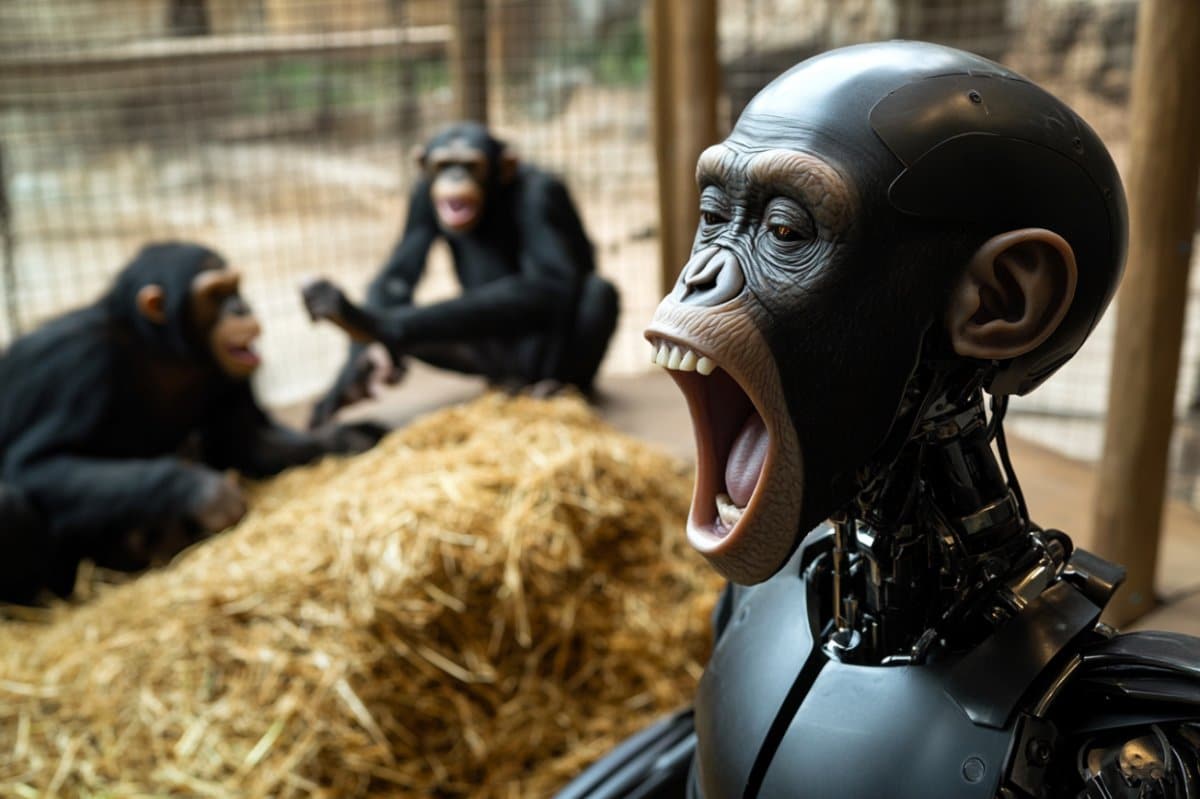Summary: Chimpanzees have been observed yawning and lying down after seeing a humanoid android mimic a yawning facial expression, indicating contagious yawning triggered by an artificial agent. This study is the first to show yawn contagion in response to an inanimate model, suggesting that yawns may serve as a rest cue in addition to a social reflex.
The strongest yawning response occurred when the robot displayed a fully open mouth, with little to no reaction during gaping or neutral expressions. These results open new doors to understanding non-verbal communication and the evolution of empathy across species.
Key Facts:
- First Inanimate Trigger: Chimpanzees showed yawn contagion to a humanoid android—an unprecedented finding.
- Graded Response: Yawn response depended on how wide the robot’s mouth opened, indicating perceptual sensitivity.
- Rest Cue Behavior: Chimpanzees also gathered bedding and lay down only during the yawning condition, suggesting a deeper behavioral link.
Source: St. George’s University of London
Chimpanzees (Pan troglodytes) can ‘catch’ yawns from an android imitating human facial expressions, according to new research from City St George’s, University of London.
The study, published in Scientific Reports, demonstrates that chimpanzees will both yawn and lie down in response to yawns made by an android, suggesting that it may act as a cue to rest rather than simply triggering an automatic response.

The findings appear to show contagious yawning due to an inanimate model for the first time, according to the authors, and the study also highlights the role of social factors in shaping yawn contagion.
Contagious yawning – where seeing another animal yawn triggers a yawn response in an individual – is primarily observed in mammals and some fish. While the evolutionary origins of yawning and yawn contagion are still unknown, some animals, including humans, can catch yawns from other species.
To test the responses of chimpanzees, Dr Ramiro Joly-Mascheroni, Honorary Research Fellow at City St George’s, Professor Beatriz Calvo-Merino, Professor Tina Forster (Professors in Cognitive Neuroscience at City St George’s), and colleagues at Universitat de Girona used an android head that could simulate facial expressions to test the responses of 14 adult chimpanzees aged between 10 and 33 years at the Fundació Mona Primate Sanctuary in Spain.
The android head generated facial expressions – ‘yawning’, ‘gaping’, and ‘neutral’ – with each facial movement lasting 10 seconds. Chimpanzees displayed contagious yawning in response to the android’s ‘yawn’.
Adult chimpanzees responded in a graded manner depending on the different android facial expressions. The highest yawn contagion occurred when the android displayed a fully wide-open mouth (‘yawning’), a reduced response when the mouth was partially opened (‘gaping’), and no contagion when the android’s mouth was closed. Only during the yawning condition did they gather bedding materials before lying down.
Lead author Dr Joly-Mascheroni said:
“Our findings show that chimpanzees exhibit yawn contagion when triggered by a non-biological inanimate agent, a humanoid android, that looks as if it is yawning.
“Despite its elusive primary functions – we still don’t know exactly why we yawn, let alone why yawning is contagious – yawning may still have an evolutionarily old, non-verbal communicative role, and its contagious aspect may help us find out more about how humans and animals developed ways of communication and social interaction.”
Professor Calvo-Merino said:
“Exploring the yawning responses of primates towards an artificial agent helps us to understand the mechanism of social cognition and interactions beyond humans. This interdisciplinary research enhances the collaboration of disciplines such as psychology, robotics and zoology.”
The researchers add that the mechanisms behind this response still require further research to clarify whether other actions performed by robots or artificial agents are contagious to animals and how similar it is to the response in humans.
About this social contagion research news
Author: George Wigmore
Source: St. George’s University of London
Contact: George Wigmore – St. George’s University of London
Image: The image is credited to Neuroscience News
Original Research: Open access.
“Chimpanzees yawn when observing an android yawn” by Ramiro Joly-Mascheroni et al. Scientific Reports
Abstract
Chimpanzees yawn when observing an android yawn
This study explores contagious yawning in adult chimpanzees (Pan troglodytes) in the presence of a non-biological humanoid agent, an android. Chimpanzees observed an android portraying specific facial expressions, including yawns and gapes.
The results showed that adult chimpanzees exhibited across-agent yawn contagion, with a graded response: the highest contagion occurred when the android displayed a fully wide-open mouth (Yawn condition), a reduced response when the mouth was partially opened (Gape condition), and no contagion when the android’s mouth was closed (Close condition).
Additionally, chimpanzees engaged in behaviours associated with drowsiness, such as gathering bedding materials, constructing nests, and lying down, while observing the android yawning.
This suggests that yawning by an unfamiliar model may act as a contextual cue for rest, rather than merely triggering a motor resonance response.
These findings contribute to the understanding of non-human primates’ susceptibility to contagiously induced behaviours, specifically yawns, even when triggered by an artificial agent.
This study highlights the role of social factors in shaping yawn contagion and calls for further research on cross-species and cross-agent interactions.






